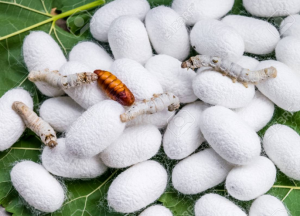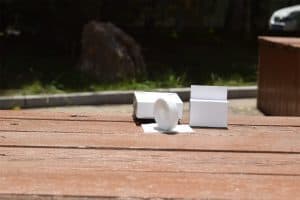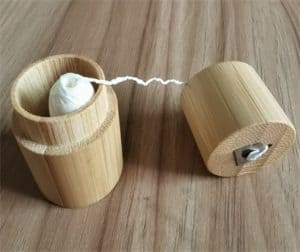1.Dental Floss Currently Situation and Environment Pollution Issue
Dental floss is a single-use plastic item, which means it can contribute to environmental pollution if not disposed of properly. While there is limited data on the exact extent of dental floss pollution, it is clear that the widespread use of dental floss is contributing to the overall plastic waste problem.
Most dental floss is made of nylon or other synthetic materials that can take hundreds of years to break down in the environment. When dental floss is improperly disposed of, it can end up in landfills or bodies of water, where it can harm wildlife and contribute to the accumulation of microplastics in the environment.
To reduce the environmental impact of dental floss, it is important to dispose of it properly. This means throwing used floss in the trash rather than flushing it down the toilet or throwing it on the ground. Additionally, using eco-friendly dental floss made from sustainable materials such as silk or bamboo can help reduce the amount of plastic waste generated from dental floss use.
Overall, while dental floss pollution may not be as widely discussed as other types of plastic waste, it is still a significant issue that individuals and dental professionals should be aware of and take steps to address.
2. Biodegradable Dental Floss Trend
There is a growing trend towards using biodegradable dental floss as people become more aware of the environmental impact of traditional dental floss, which is typically made from nylon or other synthetic materials that can take hundreds of years to break down in the environment. Biodegradable dental floss, on the other hand, is made from natural materials that can break down more quickly and safely in the environment.
There are a variety of biodegradable dental floss options available on the market today, including floss made from silk, bamboo, or other plant-based materials, as well as floss that is coated with natural waxes or oils instead of synthetic coatings.
Some companies are also offering refillable dental floss containers made from biodegradable materials, further reducing the amount of plastic waste generated by dental floss use.
While biodegradable dental floss is still a relatively small niche in the overall dental care market, it is growing in popularity as more people become aware of the importance of reducing plastic waste and choosing more sustainable products.
Overall, the trend towards biodegradable dental floss is a positive development for both dental hygiene and environmental sustainability, and is likely to continue to gain traction in the years to come.
3.What Is Biodegradable Dental Floss
Biodegradable dental floss is a type of dental floss that is designed to break down and decompose naturally in the environment. Conventional dental floss is typically made from nylon or other synthetic materials that can persist in the environment for hundreds of years, contributing to plastic pollution.
Biodegradable dental floss, on the other hand, is usually made from natural materials such as silk, bamboo, or plant-based polymers that are biodegradable and compostable. Some popular brands of biodegradable dental floss include Dental Lace, The Humble Co., and Georganics.
4.What is the biodegradable dental floss type
Currently the biodegradable dental floss can meet different group. The types are very rich.
a. PLA dental floss.
PLA (polylactic acid) floss is a type of dental floss that is made from a biodegradable and compostable material called polylactic acid (PLA). PLA is a plant-based biopolymer that is derived from renewable resources such as cornstarch, sugarcane, and cassava root. It’s a popular choice among people who are looking for a more sustainable and environmentally friendly alternative to traditional dental floss, which is often made from synthetic plastic materials.
PLA floss is similar in texture and strength to traditional floss, making it effective at removing food particles and plaque from between teeth. It’s also gentle on gums and easy to use. Unlike traditional floss, which can take hundreds of years to decompose in the environment, PLA floss is designed to break down naturally within a few months, depending on the conditions it’s exposed to.
PLA floss is a great choice for people who are concerned about reducing their environmental footprint and supporting sustainable practices. It’s also a good option for people with sensitive teeth or gums who may find traditional floss to be too harsh.
In summary, PLA floss is a biodegradable and compostable dental floss made from plant-based polylactic acid. It’s effective at removing food particles and plaque, while also being gentle on gums and environmentally friendly. It’s a great choice for people who are looking to reduce their environmental impact and support sustainable practices.
b.Silk Floss:
Silk floss is a natural and biodegradable option that is made from the fibers of the silk cocoon. Which is a type of dental floss that is made from natural silk fibers. It’s a popular choice among people who are looking for a biodegradable and sustainable alternative to traditional dental floss, which is often made from plastic materials. Silk floss is known for its softness and gentle texture, making it ideal for people with sensitive gums or teeth.
Silk dental floss is made from 100% natural silk, which is a protein fiber that is harvested from silkworms. The silk fibers are spun together to create a strong and durable thread that can be used to clean between teeth and remove food particles and plaque. Unlike traditional floss, silk floss is biodegradable and compostable, meaning it can break down naturally over time without harming the environment.
Silk dental floss is also a great choice for people who are looking for a cruelty-free product. While traditional silk production can involve harm to silkworms, there are now companies that use silk that is harvested after the silkworms have completed their life cycle and are no longer alive. This allows for the production of silk dental floss that is both sustainable and ethical.
In summary, silk dental floss is a biodegradable, sustainable, and gentle alternative to traditional dental floss. It’s made from natural silk fibers, making it ideal for people with sensitive gums or teeth. It’s also a great choice for people who are looking for a cruelty-free product that is both effective and environmentally friendly.
c.Cornstarch Floss:
Cornstarch floss is a biodegradable and compostable option made from cornstarch and coated with natural wax.
d.Bamboo Floss:
Bamboo floss is a plant-based alternative to traditional nylon floss. It is made from bamboo fibers and coated with natural wax. Bamboo floss is a type of dental floss that is made from natural bamboo fibers. It’s a popular choice among people who are looking for an eco-friendly and sustainable alternative to traditional dental floss, which is often made from synthetic plastic materials. Bamboo floss is biodegradable and compostable, meaning it can break down naturally over time without harming the environment.
Bamboo is a fast-growing, renewable resource that requires less water and fewer pesticides than other crops. The bamboo fibers used to make dental floss are typically coated with natural waxes such as candelilla or rice bran wax to make them easier to slide between teeth. Some bamboo floss may also be infused with natural essential oils for added freshness and oral health benefits.
Bamboo floss is similar in texture and strength to traditional floss, making it effective at removing food particles and plaque from between teeth. It’s also gentle on gums and easy to use. Bamboo floss is a great choice for people who are looking for a natural and sustainable dental floss option.
e.Biodegradable Nylon Floss
Some brands offer biodegradable nylon floss that is designed to break down more quickly in the environment than traditional nylon floss.
5.What Is Biodegradable Dental Floss Beneficial
It is the plastic dental floss alternative and decrease the plastic usase. It is the really natually dental floss. Making the huge contribution to protecting the world environment friendly.
6.What Is the Bidoegradable Floss Shortage
One potential downside of using biodegradable dental floss is that it may not be as strong or durable as conventional dental floss made from synthetic materials. Additionally, some people may have allergies to natural materials like silk or bamboo, so it’s important to check the ingredients before using biodegradable dental floss.
All in all, the natual floss improve the environmental protecting relization even have some shortage. The issue will be solved with the development of technology from manufacturing.
7. Tips for Choosing Biodegradable Dental Floss
Choosing the right biodegradable dental floss can make a big difference in your oral health and the environment. Here are some tips to help you choose the best biodegradable dental floss for your needs:
- Material: Biodegradable dental floss can be made from a variety of natural materials such as silk, bamboo, cornstarch, and biodegradable nylon. Consider the material when choosing floss, and choose one that is comfortable for you to use and fits your individual preferences.
- Wax coating: Some biodegradable dental floss is coated with natural wax to make it easier to slide between teeth. Consider the type of wax used, as some people may have allergies to certain types of wax. If you have sensitive teeth or gums, you may want to look for floss that is wax-free.
- Additional features: Some biodegradable dental floss comes with additional features, such as activated charcoal or essential oils. These features may help freshen your breath or provide additional benefits to your oral health.
- Packaging: Look for biodegradable dental floss that comes in eco-friendly packaging, such as recyclable or biodegradable containers. Avoid purchasing floss that comes in plastic containers or packaging, which defeats the purpose of using biodegradable dental floss.
- Reviews: Read reviews from other customers who have used the floss you are considering. This can give you an idea of its effectiveness and how it compares to other biodegradable floss brands.
8. How to Dispose of Biodegradable Dental Floss
Biodegradable dental floss is designed to break down naturally over time, unlike traditional dental floss that is made from plastic and takes hundreds of years to decompose. However, it’s important to dispose of biodegradable dental floss properly to ensure it breaks down as intended and doesn’t cause harm to the environment. Here are some tips for disposing of biodegradable dental floss:
- Composting: If you have access to a compost bin, you can dispose of biodegradable dental floss by adding it to your compost pile. The natural materials used in the floss will break down over time and add valuable nutrients to your compost.
- Trash: If you don’t have a compost bin, you can dispose of biodegradable dental floss in the trash. However, it’s important to make sure it’s not mixed in with recyclables or other items that shouldn’t go in the trash. When disposing of biodegradable dental floss in the trash, make sure to seal it in a bag to prevent it from getting tangled up with other items.
- Do not flush: It’s important not to flush biodegradable dental floss down the toilet. Although it’s designed to break down naturally, it can still cause blockages in the plumbing system and harm aquatic life if it ends up in bodies of water.
By disposing of biodegradable dental floss properly, you can help reduce plastic pollution and ensure that it breaks down as intended.
Using biodegradable dental floss can be a simple way to reduce your environmental impact and contribute to a more sustainable future. However, it’s important to note that proper disposal is key – biodegradable floss should be composted or disposed of in a landfill where it can break down naturally.



